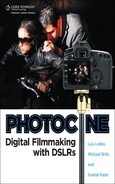
Chapter 13 talked about video editing, so at this point, your film should be looking pretty good. However, it’s not quite there yet. That’s because it needs finishing work: color correction, sound mixing, and graphics/titles. Every feature film or short film you see these days goes through some amount of finishing work. Sci-fi films that are heavily dependent on VFX (that’s visual effects) go through a lot of finishing work.
As mentioned in the previous section, finishing can involve any number of processes, depending on the look you’re trying to achieve. This includes color correction, sound mixing, adding filters, adding graphics and titles, and more.
Color correction is akin to Photoshop-ing still photographs. You can do as much or as little as you want. It’s all up to your creativity and time. You can change the time of day, punch up or desaturate the color, emulate different film emulsions and processes, vignette your image, blur sections to call attention to your subject, correct for mistakes in exposure during filming, and much, much more.
A great tool for any budding filmmaker to try is Red Giant Software’s Magic Bullet Looks. It’s both a standalone application and a plug-in for a whole host of applications, including AVID, Final Cut, Premiere, After Effects, and Vegas. I like to use it in Final Cut because I can drop in as an effect on a clip in the timeline. Instead of trying to build a look by using Final Cut’s three-way color corrector plus gamma filters, film-look filters, vignettes, and blurs, all I have to do is use the Looks Builder plug-in and then render once per clip.
There are over 100 preset looks that you can use to transform your video. You can work with one clip at a time and copy/paste your settings for subsequent clips in the timeline. I used Magic Bullet Looks to color the web series, “The Eggie Files.” You can see just how much the original clip is transformed by a series of settings within the Looks Builder. There are an infinite number of combinations that you can come up with to create your own look.
I experimented with the presets before settling on something that looked more like film than video. The web series was shot on the Canon 7D, using the Faithful picture style. I like this picture style because the image isn’t contrasty and the colors aren’t saturated. This is different from the Standard picture style, which is when the camera attempts to make the image look “pretty” by using sharpness, contrast, and saturation. Faithful is flat enough to let you see into the grays, but isn’t so flat that you will have trouble deciding on proper exposure while filming.

The original image from “The Eggie Files”

The “The Eggie Files” image, placed into Red Giant Software’s Magic Bullet Looks
For a lot of graphics and special effects work, I like to use Adobe After Effects. In fact, I’m working on a new Sci-Fi project right now, and I have been tuning into www.VideoCoPilot.net to get a lot of tips and tricks in creating low-budget special effects that look fantastic! After Effects is another timeline-based editing system, but it is designed for compositing different mediums like photos, video, graphics, text, and animation onto one film plane to create cool-looking effects.
A very import part of finishing work for a film is the sound and music mix. Sound is even more important to me than the graphical aspect when it comes to films. You can have crappy video, but as long as the story is interesting and the sound is stellar, the audience will listen and pay attention. If you don’t believe me, watch Paranormal Activity and try to find one good-looking shot in the whole film.
Many people try to use their video-editing software for doing their sound mix. I think you are really limiting yourself when doing this because most editing applications are frame-based and will not let you make audio changes that are less than one frame in length. The only exception is Sony Vegas, which was originally a sound-editing application (way back in version 1).
If you want to attempt sound editing, or if you want to hand over your sound mix to a post house, you will probably be outputting OMF files. OMF is a standardized sound format that outputs each track of your audio from the video-editing timeline while giving each audio clip handles so that the sound mixer can make adjustments and add fades if needed. See your editing application’s help files for instructions on how to make an OMF file.
When you output an OMF, you should also make a low-quality video/audio output of your timeline (see Chapter 12, “Transcoding and Encoding for Ingestion and Output”) as a reference for the sound mixer. Audio software like ProTools or SoundTrack Pro have a way to line up the OMF tracks with the reference video for playback during a mix session.

